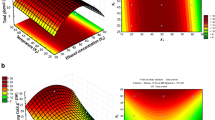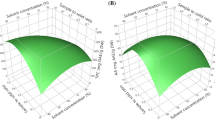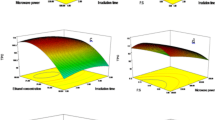Abstract
Mahonia bealei (Fort.) Carr., is an economic plant cultivated in Southwest China commonly used in traditional Chinese medicine. In this study, a response surface methodology was used to optimize experimental conditions for the extraction of phenolic compounds from the leaves of Mahonia bealei (Fort.) Carr. The highest extraction ratio of phenolic compounds yielded 39.1 mg gallic acid equivalent/g of dry weight using an ethanol concentration of 30% (v/v) as a solvent and a liquid-to-solid ratio of 21:1 (mL·g-1) for 2 h in 63°C. The crude material was extracted under optimal conditions, enriched, and then purified through a D-101 macroporous adsorption resin, giving a phenolic compound-enriched fraction we named TPMB. Evaluation of its in vitro antioxidant activity suggested that TPMB significantly scavenged the 1,1-diphenyl-2-picrylhydrazyl (DPPH) free radical, superoxide radical, and hydrogen peroxide in a concentration-dependent manner. In addition, TPMB also exhibited a strong reducing ability and provided protection against oxidative damage induced by oxidative stress in cellular antioxidant activity assays. The results from this study indicate the suitability of the response surface methodology in optimizing the solvent extraction of phenolic compounds from M. bealei. Further research showed that TPMB possesses a strong anti-radical activity and may be an effective oxidation resistance treatment in the medical and food industries.
Similar content being viewed by others
Literature Cited
Anissi J, El Hassouni M, Ouardaoui A, Sendide K (2014) A comparative study of the antioxidant scavenging activity of green tea, black tea and coffee extracts: A kinetic approach. Food Chem 150:438–447
Bhuyan DJ, Vuong QV, Chalmers AC, Van Altena IA, Bowyer MC, Scarlett CJ (2015) Microwave-assisted extraction of Eucalyptus robusta leaf for the optimal yield of total phenolic compounds. Ind Crop Prod 69:290–299
Canabady-Rochelle LLS, Harscoat-Schiavo C, Kessler V, Aymes A, Fournier F, Girardet JM (2015) Determination of reducing power and metal chelating ability of antioxidant peptides: Revisited methods. Food Chem 183:129–135
Chao J, Lu TC, Liao JW, Huang TH, Lee MS, Cheng HY, Ho LK, Kuo CL, Peng WH (2009) Analgesic and anti-inflammatory activities of ethanol root extract of Mahonia oiwakensis in mice. J Intercult Ethnopharmacol 125:297–303
Duthie GG, Duthie SJ, Kyle JA (2000) Plant polyphenols in cancer and heart disease: implications as nutritional antioxidants. Nutr Res Rev 13:79–106
Guo L, Zhu WC, Liu YT, Wu JY, Zheng AQ, Liu YL (2013) Response surface optimized extraction of flavonoids from mimenghua and its antioxidant activities in vitro. Food Sci Biotechnol 22:1–8
Guo S, Deng Q, Xiao J, Xie B, Sun Z (2007) Evaluation of antioxidant activity and preventing DNA damage effect of pomegranate extracts by chemiluminescence method. J Agr Food Chem 55:3134–3140
He JM, Mu Q (2015) The medicinal uses of the genus Mahonia in traditional Chinese medicine: An ethnopharmacological, phytochemical and pharmacological review. J Ethnopharmacol 175:668–683
Hooshmand S, Kumar A, Zhang JY, Johnson, S, Chai S, Arjmandi B (2015) Evidence for anti-inflammatory and antioxidative properties of dried plum polyphenols in macrophage RAW 264.7 cells. Food Funct 6:1719–1725
Hu WC, Yu LL, Wang MH (2011) Antioxidant and antiproliferative properties of water extract from Mahonia bealei (Fort.) Carr. leaves. Food Chem Toxicol 49:799–806
Li A, Zhu Y, He XB, Tian XJ, Xu L, Ni W, Jiang P (2008) Evaluation of antimicrobial activity of certain Chinese plants used in folkloric medicine. World J Microb Biot 24:569–572
Li AR, Zhu Y, Li XN, Tian XJ (2007) Antimicrobial activity of four species of Berberidaceae. Fitoterapia 78:379–381
Li Y, Ji X, Liu HW, Yan Y, Li JS (2000) Characterization of 10 species of Mahonia by capillary electrophoresis. Chromatographia 51:357–361
Liu J, Henkel T (2002) Traditional Chinese medicine (TCM): are polyphenols and saponins the key ingredients triggering biological activities? Curr Med Chem 9:1483–1485
Lv HP, Dai WD, Tan JF, Guo L, Zhu Y, Lin Z (2015) Identification of the anthocyanins from the purple leaf coloured tea cultivar Zijuan (Camellia sinensis var. assamica) and characterization of their antioxidant activities. J Funct Foods 17:449–458
Marcos AB, Ricardo ES, Eliane PO, Leonardo SV, Luciane AE (2008) Response surface methodology (RSM) as a tool for optimization in analytical chemistry. Talanta 76:965–977
Medinia F, Bourgoua S, Lalancettec K, Snoussib M, Mkadminia K, Cotéc I, Abdellya C, Legaultc J, Ksouria R (2015) Phytochemical analysis, antioxidant, anti-inflammatory, and anticancer activities of the halophyte Limonium densiflorum extracts on human cell lines and murine macrophages. S Afr J Bot 99:158–164
Pasinetti GM, Wang J, Ho L, Zhao W, Dubner L (2015) Roles of resveratrol and other grape-derived polyphenols in Alzheimer's disease prevention and treatment. BBA-Mol Basis Dis 1852:1202–1208
Pathirana CL, Shahidi F (2005) Optimization of extraction of phenolic compounds from wheat using response surface methodology. Food Chem 93:47–56
Pompeu DR, Silva EM, Rogez H (2009) Optimisation of the solvent extraction of phenolic antioxidants from fruits of Euterpe oleracea using Response Surface Methodology. Bioresour Technol 100: 6076–6082
Pulido R, Bravo L, Saura-Calixto F (2000) Antioxidant activity of dietary polyphenols as determined by a modified ferric reducing/antioxidant power assay. J Agric Food Chem 48:3396–3402
Pyrkosz-Biardzka K, Kucharska AZ, Sokół-Łętowska A, Strugała P, Gabrielska J (2014) A comprehensive study on antioxidant properties of crude extracts from fruits of Berberis vulgaris L., Cornus mas L. and Mahonia aquifolium Nutt. Pol J Food Nutr Sci 64:91–99
Rackova L, Oblozinsky M, Kostalova D, Kettmann V, Bezakova L (2007) Free radical scavenging activity and lipoxygenase inhibition of Mahonia aquifolium extract and isoquinoline alkaloids. J Inflamm-Lond 4:1–6
Roby MHH, Sarhan MA, Hamed Selim KA, Khalel KI (2013) Evaluation of antioxidant activity, total phenols and phenolic compounds in thyme (Thymus vulgaris L.), sage (Salvia officinalis L.), and marjoram (Origanum majorana L.) extracts. Ind Crop Prod 43:827–831
Scalbert A, Johnson IT, Saltmarsh M (2005) Polyphenols: antioxidants and beyond. Am J Clin Nutr 8:215S–217S
Shah RK (2015) Antioxidant activity and estimation of total phenols and flavonoids in extracts of Smilax ovalifolia leaves. Int J Pure App Biosci 3:174–177
Tauchen J, Doskocil Ivo, Caffi C, Ermias L, Marsik P, Havlik J, Damme PV, Kokoska Ladislav (2015) In vitro antioxidant and anti-proliferative activity of Ethiopian medicinal plant extracts. Ind Crop Prod 74: 671–679
Wolfe KL, Kang XM, He XJ, Dong M, Zhang QY, Liu RH (2008) Cellular antioxidant activity of common fruits. J Agric Food Chem 56:8418–8426
Xu CM, Yagiz Y, Hsu WY, Simonne A, Lu J, Marshall MR (2014) Antioxidant, antibacterial, and antibiofilm properties of polyphenols from muscadine grape (Vitis rotundifolia Michx.) pomace against selected foodborne pathogens. J Agric Food Chem 62:6640–6649
Yao H, Wu B, Cheng YY, Qu HB (2009) High throughput chemiluminescence platform for evaluating antioxidative activity of total flavonoid glycosides from plant extracts. Food Chem 115:380–386
Zeng XY, Dong YL, Sheng GY, Dong XC, Sun XH, Fu JM (2006) Isolation and structure determination of anti-influenza component from Mahonia bealei. J Ethnopharmacol 108: 317–319
Zhang L, Ravipati AS, Koyyalamudi SR, Jeong SC, Reddy N, Smith PT, Bartlett J, Shanmugam K, Münch G, Wu MJ, et al (2011) Antioxidant and anti-inflammatory activities of selected medicinal plants containing phenolic and flavonoid compounds. J Agric Food Chem 59:12361–12367
Zhang SL, Li H, He X, Zhang RQ, Sun YH, Zhang CF, Wang CZ, Yuan CS (2014) Alkaloids from Mahonia bealei posses anti-H+/K+-ATPase and anti-gastrin effects on pyloric ligation-induced gastric ulcer in rats. Phytomedicine 21:1356–1363
Zhang Y, Zou BQ, Fang YL, Yi XH, Pan YM (2011) Antioxidant activity of extract from Mahonia bealei fruit. Journal of Guangxi Normal University (Natural Science Edition) 29:43–46
Zhao TF, Wang XK, Rimando AM, Che CT (1991) Folkloric medicinal plants: Tinospora sagittata var. cravaniana and Mahonia bealei. Planta Med 57:505
Author information
Authors and Affiliations
Corresponding author
Additional information
These authors contributed equally to this work.
Rights and permissions
About this article
Cite this article
Wu, L., Wang, G., Shen, T. et al. Optimizing conditions for antioxidant phenolic compound extraction from Mahonia bealei (Fort.) Carr. leaves using a response surface methodology. Hortic. Environ. Biotechnol. 58, 282–291 (2017). https://doi.org/10.1007/s13580-017-0106-4
Received:
Revised:
Accepted:
Published:
Issue Date:
DOI: https://doi.org/10.1007/s13580-017-0106-4




